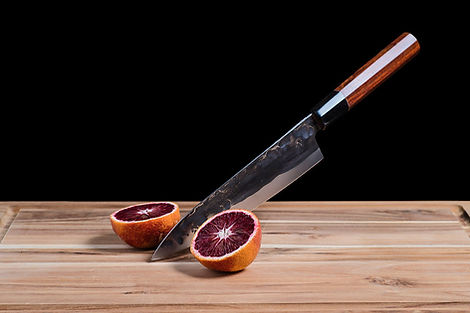
Knife Care
Essential Care Tips for Your Japanese-Style Forge To Table Knife

Initial Cleaning
Before using your Japanese-style knife for the first time, it's essential to give it a thorough wash to remove any residual food-safe mineral oil that may have been applied for transportation.
Oiling (if needed)
If your Japanese-style knife will be sitting idle for an extended period, particularly in environments with extreme temperatures or varying humidity levels, consider oiling the blade and handle. This precautionary measure helps protect against potential damage and ensures the longevity of your knife. Remember, a natural patina may develop over time, which is entirely normal.
Dealing with Rust
In the unfortunate event that rust occurs due to prolonged exposure to moisture, don't panic. Simply grab some soap or Bartenders Friend™ and a rough sponge. Gently scrub away the tarnish, wash the knife, and promptly dry it. This quick action can help restore your knife to its former glory.
Caution when Cutting
Handle your Japanese-style knife with care, especially when cutting through tough materials like raw bones or ice. Always use a suitable cutting surface to avoid damaging the blade. Refrain from cutting on surfaces like glass, marble, or granite, as these can dull or chip the knife's edge.


Storage
When not in use, store your Japanese-style knife in a knife block, on a magnetic strip, or in a knife Saya. Proper storage helps protect the blade and prevents accidents. Avoid storing knives in drawers where they can come into contact with other utensils, which may cause nicks or damage.
Drying
After washing your knife, thoroughly dry it with a soft cloth to prevent water spots and potential rust formation. Pay special attention to drying the knife's handle and the area where the blade meets the handle.
Avoiding the Dishwasher
Never put your Japanese-style knife in the dishwasher, as the harsh detergents and high heat can damage the blade and handle. Handwashing is the best method to preserve the quality and longevity of your knife.
Sharpening
Regularly hone and sharpen your knife to maintain its edge. You can use a sharpening stone or a honing steel for this purpose. Take care to follow proper sharpening techniques to avoid over-sharpening or damaging the blade.



































